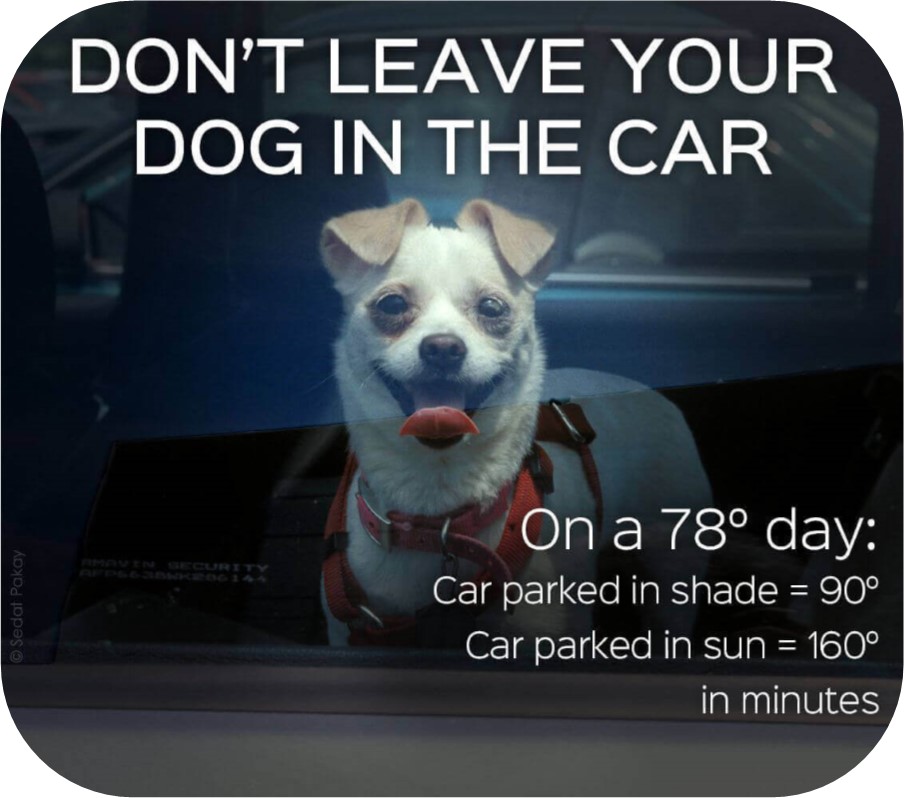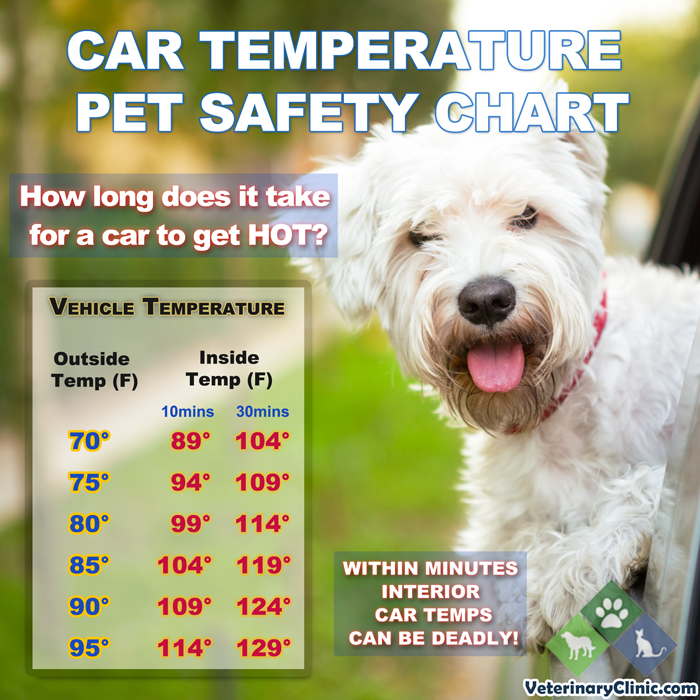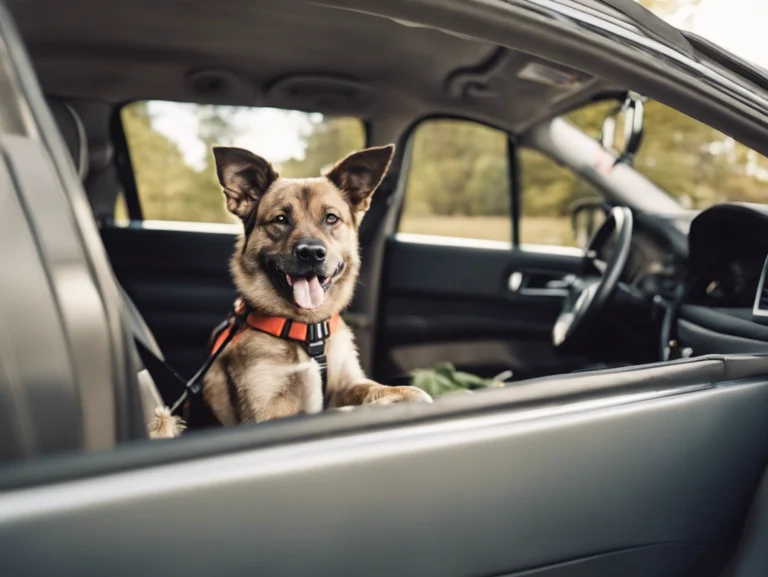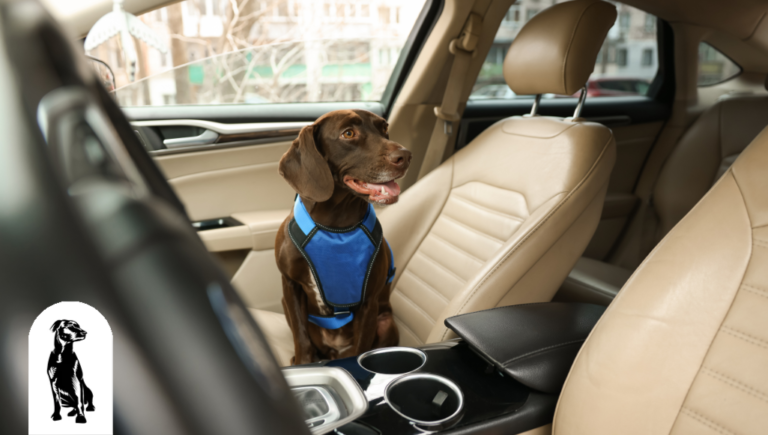How Long Can You Safely Leave a Dog in a Car? Essential Tips
You should never leave a dog in a car for more than a few minutes. Even short periods can be dangerous.
Leaving a dog in a car can quickly become life-threatening. Temperatures inside a vehicle can soar, even on mild days. A car can become a furnace in minutes, risking heatstroke and death for pets. Dogs are more sensitive to heat than humans.
They rely on panting to cool down, which is ineffective in a hot car. Cracking windows open does little to reduce the temperature. Always prioritize your pet’s safety. Plan trips to avoid leaving your dog alone in the car. If you must bring your pet, ensure they are safe and comfortable at all times.

Credit: franklinpet.com
Introduction To Dog Safety In Vehicles
Dogs are beloved family members. Keeping them safe is a top priority. One key aspect of their safety is ensuring they are never left alone in vehicles. Understanding the dangers and risks involved is crucial for every pet owner.
The Risks Of Leaving Dogs In Cars
Leaving a dog in a car can be extremely dangerous. Even on a mild day, temperatures inside a car can rise quickly. Dogs are more sensitive to heat than humans. They can overheat in minutes. Heatstroke can occur rapidly, leading to serious health issues or death.
Here are some risks associated with leaving dogs in cars:
- Heatstroke: Dogs cannot regulate their body temperature as efficiently as humans.
- Dehydration: Rapid temperature increases can cause severe dehydration.
- Anxiety and Stress: Being confined in a small space can cause extreme anxiety.
- Potential Theft: Unattended pets are vulnerable to theft.
Understanding Temperature Dynamics Inside A Car
Temperature dynamics inside a car can be deceiving. Even if the weather feels cool, the interior of a car can heat up quickly. A car’s interior can reach dangerous temperatures within 10 minutes.
| Outside Temperature | Temperature Inside Car (10 mins) | Temperature Inside Car (30 mins) |
|---|---|---|
| 70°F (21°C) | 89°F (32°C) | 104°F (40°C) |
| 80°F (27°C) | 99°F (37°C) | 114°F (46°C) |
| 90°F (32°C) | 109°F (43°C) | 124°F (51°C) |
The data clearly shows how quickly temperatures can escalate. Even with windows cracked open, the temperature inside a car can still reach dangerous levels. It is essential to understand these dynamics to keep your dog safe.
Factors Affecting Canine Car Safety
Leaving a dog in a car can be dangerous. Various factors can affect your dog’s safety. Understanding these factors can help you make better decisions.
Breed-specific Vulnerabilities
Different dog breeds have unique needs and vulnerabilities. Some breeds are more sensitive to heat. For example, brachycephalic breeds like Bulldogs and Pugs struggle in hot weather. Their short noses make it hard for them to cool down.
Smaller breeds also have a higher risk. They can overheat quickly. Larger breeds may tolerate temperatures better but still face risks. Always consider your dog’s breed before leaving them in a car.
Effects Of Weather Conditions
Weather plays a major role in canine car safety. On a sunny day, a car’s temperature can rise rapidly. Even with the windows cracked, cars can become ovens.
In cold weather, cars can become too cold. Dogs can suffer from hypothermia. Weather conditions can change fast. Always check the weather forecast before leaving your dog in the car.
Use this table to understand how quickly a car can heat up:
| Outside Temperature (°F) | Temperature Inside Car (°F) in 10 Minutes | Temperature Inside Car (°F) in 30 Minutes |
|---|---|---|
| 70°F | 89°F | 104°F |
| 80°F | 99°F | 114°F |
| 90°F | 109°F | 124°F |
As you can see, a car’s interior can become dangerous very quickly. Always be cautious and prioritize your dog’s safety.
The Science Of Car Temperatures
Understanding how car temperatures change is vital for your dog’s safety. Even on mild days, a car can become dangerously hot very fast. This section explores how cars heat up and how temperature fluctuations can impact your dog.
How Cars Heat Up
Cars act like ovens in the sun. Even with windows cracked open, temperatures can rise rapidly.
| Outside Temperature (°F) | Inside Car Temperature (°F) in 10 minutes | Inside Car Temperature (°F) in 30 minutes |
|---|---|---|
| 70°F | 89°F | 104°F |
| 75°F | 94°F | 109°F |
| 80°F | 99°F | 114°F |
As seen in the table, a mere 10-minute wait can increase the car’s temperature significantly. This rise in temperature happens even faster in darker-colored cars.
Temperature Fluctuations And The Impact On Dogs
Dogs are more sensitive to heat than humans. They don’t sweat like we do; they pant to cool down.
- A dog’s normal body temperature is between 101°F and 102.5°F.
- Heatstroke can occur when their body temperature reaches 104°F.
- Temperatures over 106°F can be fatal in minutes.
Even short periods in a hot car can cause serious health risks or death. It’s crucial to understand these dangers to keep your dog safe.
Legal Considerations And Animal Welfare Laws
Leaving a dog in a car can be risky. Knowing the laws is crucial. Each state has different rules. These laws protect animals. Ignoring them can lead to serious consequences.
State-specific Legislation
The laws about leaving dogs in cars vary. Some states have specific rules. In California, it’s illegal to leave a pet in dangerous conditions. This includes hot or cold weather.
In Florida, a dog left in a car must have proper ventilation. Many states allow law enforcement to break into cars. They do this to rescue pets in distress.
| State | Specific Legislation |
|---|---|
| California | Illegal to leave pets in dangerous conditions |
| Florida | Must provide proper ventilation |
| Arizona | Law enforcement can break into cars to rescue pets |
Always check your local laws. They are there to protect your pets.
Consequences Of Law Violations
Violating these laws can have serious consequences. Fines are common. In some states, jail time is possible. Your pet could be taken away. You might face animal cruelty charges.
- Fines: Ranging from $100 to $1,000
- Jail Time: Up to six months in some states
- Animal Custody: Pet could be removed from your care
- Criminal Charges: Animal cruelty charges may be filed
Legal consequences are severe. They aim to prevent animal suffering. Always prioritize your pet’s safety.
Guidelines For Short-term Waiting
Leaving your dog in a car, even for a short time, can be risky. Proper guidelines help ensure your pet’s safety and well-being.
Safe Time Frames
Temperature and weather significantly impact how long your dog can stay in a car. In cool weather, a dog might be okay for up to 10 minutes. In hot weather, it’s best to avoid leaving your dog in the car at all.
| Temperature | Safe Time Frame |
|---|---|
| Cool (below 70°F) | Up to 10 minutes |
| Warm (70-85°F) | 5 minutes or less |
| Hot (above 85°F) | Not recommended |
Monitoring Your Dog
Constant monitoring is essential. Use pet cameras or other devices to keep an eye on your dog. Check the car frequently to ensure your dog is comfortable.
- Crack the windows for ventilation.
- Park in the shade if possible.
- Leave water for your dog.
Never leave your dog unattended for long periods. Always prioritize your pet’s safety and health.

Credit: olddoghaven.org
Protective Measures For Dog Owners
Leaving your dog in the car can be dangerous. As a responsible pet owner, taking protective measures ensures your furry friend’s safety. Below are some practical tips to keep your dog safe when you need to leave them in the car briefly.
Proper Ventilation Techniques
Ensuring proper ventilation is crucial. Open windows slightly to allow fresh air to circulate. This helps to prevent the car from becoming too hot.
Cross-ventilation can be effective. Open windows on opposite sides of the car. This creates a breeze to cool the interior.
Consider using battery-powered fans. They can help to keep the air moving inside the car.
Using Sunshades And Cooling Gadgets
Sunshades can block out direct sunlight. This helps to reduce the temperature inside the car.
Place sunshades on all windows. This provides maximum protection from the sun’s heat.
Cooling gadgets can be lifesavers. Use cooling mats or cooling vests for your dog. These products absorb heat and help to keep your dog cool.
Portable air conditioners are another option. These devices can keep the car’s interior temperature comfortable.
| Protective Measure | Benefits |
|---|---|
| Proper Ventilation | Prevents overheating by allowing fresh air to circulate |
| Sunshades | Reduces direct sunlight and lowers interior temperature |
| Cooling Gadgets | Keeps your dog cool through absorption and air conditioning |
- Keep water available for your dog. Hydration is essential.
- Never leave your dog unattended for long periods.
- Park in shaded areas to avoid direct sunlight.
Following these protective measures can ensure your dog’s safety in the car. Always prioritize your pet’s well-being.
Emergency Situations And Bystander Intervention
Leaving a dog in a car can quickly become dangerous. Even on mild days, the temperature inside a car can rise rapidly. As a bystander, knowing how to act in an emergency can save a dog’s life. This section will help you recognize distress signals and respond appropriately.
Recognizing Distress Signals
It’s crucial to recognize signs of distress in dogs. Dogs in hot cars can overheat quickly. Look for these signals:
- Heavy panting or drooling
- Glassy eyes
- Rapid heartbeat
- Vomiting
- Weakness or collapse
If you see any of these signs, the dog is in immediate danger. You must act fast to help.
How To Respond To A Dog In Danger
If you find a dog in a hot car, follow these steps:
- Assess the situation: Check if the dog is showing distress signals.
- Locate the owner: Look for the owner nearby or in surrounding shops.
- Call for help: Contact local authorities or animal control.
- Stay with the dog: Provide shade and water if possible.
- Document the situation: Take notes or pictures as evidence.
Never leave the scene until help arrives. Your quick actions can save a dog’s life.
Here’s a quick reference table for emergency steps:
| Step | Action |
|---|---|
| 1 | Assess the situation |
| 2 | Locate the owner |
| 3 | Call for help |
| 4 | Stay with the dog |
| 5 | Document the situation |
By recognizing distress signals and knowing how to respond, you can act swiftly in emergencies. Your intervention can make a crucial difference.

Credit: www.cambridgema.gov
Alternatives To Leaving Your Dog In The Car
Finding alternatives to leaving your dog in the car is crucial for their safety and well-being. Dogs can suffer from heatstroke or hypothermia in extreme temperatures. There are many ways to keep your dog safe while you run errands or travel.
Dog-friendly Businesses And Facilities
Many businesses welcome dogs. Pet stores, cafes, and some retail stores often allow pets inside. Call ahead to see if your destination is dog-friendly.
Veterinary clinics sometimes offer short-term boarding options. This is a safe choice if you cannot take your dog with you.
Doggy daycare centers provide a fun and safe environment for your dog. These centers usually have trained staff to watch over pets.
Traveling With Pets
Plan your trips to include your dog. Research dog parks, rest stops, and pet-friendly hotels. This keeps your pet comfortable and happy.
Use a travel crate or pet seat belt to keep your dog secure in the car. Never leave your dog unattended for long periods.
Create a travel checklist for your dog. Include water, food, a leash, and waste bags. This ensures you have everything your dog needs.
Take breaks during long trips. Allow your dog to stretch, relieve itself, and drink water. This keeps your dog healthy and happy.
Consider a pet-sitting service if you cannot take your dog with you. Many professional pet sitters offer in-home visits or boarding.
Conclusion: Promoting Responsible Pet Ownership
Ensuring the safety and well-being of our pets is a fundamental part of responsible pet ownership. Leaving a dog in a car can be dangerous, even for a short time. It is crucial to understand the risks and take steps to avoid them. This includes never leaving pets in vehicles unattended, especially in extreme weather conditions.
Key Takeaways
- Temperatures inside cars can rise quickly.
- Even on mild days, the interior can become dangerously hot.
- Heatstroke can occur within minutes.
- Dogs are more susceptible to heat than humans.
- Leaving a window open does not provide enough cooling.
Encouraging Community Awareness
Promoting awareness in your community is essential. Encourage friends, family, and neighbors to understand the risks of leaving dogs in cars. Share information through social media, flyers, and local events.
| Action | Benefit |
|---|---|
| Use social media | Reach a wider audience quickly. |
| Distribute flyers | Provide physical reminders in your local area. |
| Host local events | Engage directly with the community. |
By spreading the word, we can help prevent tragic accidents. Your efforts can save lives. Be a role model for responsible pet ownership.
Frequently Asked Questions
How Long Can A Dog Be Left In A Car?
Dogs should not be left in a car for more than 10 minutes. Temperatures can quickly become dangerous.
Is It Ok To Leave Dog In Car For 15 Minutes?
Leaving a dog in a car for 15 minutes is unsafe. Temperatures can rise quickly, causing heatstroke or death.
Is It Better To Leave Dog At Home Or In Car?
It’s safer to leave your dog at home. Cars can quickly become too hot or cold, risking your pet’s health.
Is 70 Degrees Too Hot For A Dog?
70 degrees is generally safe for most dogs. Ensure they have water, shade, and avoid strenuous activities.
Conclusion
Leaving a dog in a car can be dangerous, even for a short time. Always consider the temperature and ventilation. It’s crucial to prioritize your pet’s safety. If in doubt, it’s best to take your dog with you. A little extra effort can prevent serious harm or even save a life.
- Can I Get in a Taxi Without a Car Seat? - January 26, 2025
- Can I Get Chlamydia From a Toilet Seat? - January 26, 2025
- Can I Get an Uber With a Car Seat? - January 26, 2025






